Broadband High-Gain Antenna for Millimetre-Wave 60-GHz Band
Abstract
1. Introduction
2. Proposed Modified Log-Periodic Antenna
2.1. Log-Periodic and Yagi–Uda Principles
2.2. Description of the Proposed Antenna Concept
3. Simulation Results
3.1. Number of Radiating Sections
3.2. Parametric Study of the Antenna Multisections
3.2.1. First Section Parametric Study
3.2.2. Second Section Parametric Study
3.2.3. Third Section Parametric Study
3.2.4. Fourth Section Parametric Study
4. Optimal Design and Discussion
5. Experimental Results
6. Conclusions
Author Contributions
Funding
Acknowledgments
Conflicts of Interest
References
- Nitsche, T.; Cordeiro, C.; Flores, A.B.; Knightly, E.W.; Perahia, E.; Widmer, J.C. IEEE 802.11 ad: Directional 60 GHz communication for multi-Gigabit-per-second Wi-Fi. IEEE Commun. Mag. 2014, 52, 132–141. [Google Scholar] [CrossRef]
- Scott-Hayward, S.; Garcia-Palacios, E. Multimedia resource allocation in mm-wave 5G networks. IEEE Commun. Mag. 2015, 53, 240–247. [Google Scholar] [CrossRef]
- Biglarbegian, B.; Fakharzadeh, M.; Busuioc, D.; Nezhad-Ahmadi, M.R.; Safavi-Naeini, S. Optimized microstrip antenna arrays for emerging millimeter-wave wireless applications. IEEE Trans. Antennas Propag. 2011, 59, 1742–1747. [Google Scholar] [CrossRef]
- Balanis, C.A. (Ed.) Modern Antenna Handbook; John Wiley and Sons: Hoboken, NJ, USA, 2011. [Google Scholar]
- Murugan, D.; Madhan, M.G.; Piramasubramanian, S. Design and performance prediction of 10GHz micro strip array antenna structures. In Proceedings of the 2012 Third International Conference on Computing, Communication and Networking Technologies (ICCCNT), Coimbatore, India, 26 July 2012; pp. 1–5. [Google Scholar]
- Liu, J.; Vosoogh, A.; Zaman, A.U.; Yang, J. Design and Fabrication of a High-Gain 60-GHz Cavity-Backed Slot Antenna Array Fed by Inverted Microstrip Gap Waveguide. IEEE Trans. Antennas Propag. 2017, 65, 2117–2122. [Google Scholar] [CrossRef]
- Karnfelt, C.; Hallbjorner, P.; Zirath, H.; Alping, A. High gain active microstrip antenna for 60-GHz WLAN/WPAN applications. IEEE Trans. Microw. Theory Tech. 2006, 54, 2593–2603. [Google Scholar] [CrossRef]
- Li, Y.; Luk, K.M. Low-cost high-gain and broadband substrate-integrated-waveguide-fed patch antenna array for 60-GHz band. IEEE Trans. Antennas Propag. 2014, 62, 5531–5538. [Google Scholar] [CrossRef]
- Wang, L.; Guo, Y.X.; Sheng, W.X. Wideband high-gain 60-GHz LTCC L-probe patch antenna array with a soft surface. IEEE Trans. Antennas Propag. 2013, 61, 1802–1809. [Google Scholar] [CrossRef]
- Rabbani, M.S.; Ghafouri-Shiraz, H. High gain microstrip antenna array for 60 GHz band point to point WLAN/WPAN communications. Microw. Opt. Technol. Lett. 2017, 59, 511–514. [Google Scholar] [CrossRef]
- Li, Y.; Luk, K.M. 60-GHz substrate integrated waveguide fed cavity-backed aperture-coupled microstrip patch antenna arrays. IEEE Trans. Antennas Propag. 2015, 63, 107–1085. [Google Scholar] [CrossRef]
- Zhang, T.; Li, L.; Xia, H.; Zhao, D.; Cu, T. Low-cost aperture coupled integrated 60 GHz phased array antenna in PCB process. In Proceedings of the 2016 IEEE International Symposium on Antennas and Propagation (APSURSI), Fajardo, Puerto Rico, 26 June–1 July 2016; pp. 439–440. [Google Scholar]
- Jin, H.; Che, W.; Chin, K.S.; Shen, G.; Yang, W.; Xue, Q. 60- GHz LTCC Differential-Fed Patch Antenna Array with High Gain by Using Soft-Surface Structures. IEEE Trans. Antennas Propag. 2017, 65, 206–216. [Google Scholar] [CrossRef]
- Jouanlanne, C.; Clemente, A.; Huchard, M.; Keignart, J.; Barbier, C.; Le Nadan, T.; Petit, L. Wideband linearly polarized transmitarray antenna for 60 GHz backhauling. IEEE Trans. Antennas Propag. 2017, 65, 1440–1445. [Google Scholar] [CrossRef]
- Cheema, H.M.; Shamim, A. The last barrier: On-chip antennas. IEEE Microwave Mag. 2013, 14, 79–91. [Google Scholar] [CrossRef]
- Campbell, C.; Traboulay, I.; Suthers, M.; Kneve, H. Design of a stripline log-periodic dipole antenna. IEEE Trans. Antennas Propag. 1977, 25, 718–721. [Google Scholar] [CrossRef]
- Vettikalladi, H.; Lafond, O.; Himdi, M. High-efficient and high-gain superstrate antenna for 60-GHz indoor communication. IEEE Antennas Wirel. Propag. Lett. 2009, 8, 1422–1425. [Google Scholar] [CrossRef]
- Nuthakki, V.R.; Dhamodharan, S. UWB Metamaterial-based miniaturized planar monopole antennas. AEU-Int. J. Electron. Commun. 2017, 82, 93–103. [Google Scholar] [CrossRef]
- Zhai, G.; Cheng, Y.; Yin, Q.; Chiu, L.; Zhu, S.; Gao, J. Super high gain substrate integrated clamped-mode printed log-periodic dipole array antenna. IEEE Trans. Antennas Propag. 2013, 61, 3009–3016. [Google Scholar] [CrossRef]
- Peixeiro, C. Design of log-periodic dipole antennas. IEE Proc. H (Microw. Antennas Propag.) 1988, 135, 98–102. [Google Scholar] [CrossRef]
- Logarithmic Periodic Dipole Antenna Calculator. Available online: https://www.changpuak.ch/electronics/lpda.php (accessed on 18 September 2019).
- Chen, C.; Cheng, D. Optimum element lengths for Yagi-Uda arrays. IEEE Trans. Antennas Propag. 1975, 23, 8–15. [Google Scholar] [CrossRef]
- Cheng, D.K. Gain optimization for Yagi-Uda arrays. IEEE Antennas Propag. Mag. 1991, 33, 42–46. [Google Scholar] [CrossRef]
- Rabbani, M.S.; Ghafouri-Shiraz, H. A dual band patch antenna designed with size improvement method for 60 GHz band duplexer applications. Microw. Opt. Technol. Lett. 2017, 59, 2867–2870. [Google Scholar] [CrossRef]
- Zhang, G.; Pu, S.; Xu, X.; Liu, Y.; Wang, C. Design of 60-GHz microstrip antenna array composed through circular contour feeding line. In Proceedings of the IEEE Asia-Pacific International Symposium on Electromagnetic Compatibility (APEMC), Shenzhen, China, 17–21 May 2016; Volume 1, pp. 1010–1013. [Google Scholar]
- Zhang, G.; Pu, S.; Liu, Z.R.; Liu, W.F. Design of 60 GHz microstrip antenna array composed through annular feeding line. In Proceedings of the 2016 IEEE International Symposium on Antennas and Propagation (APSURSI), Fajardo, Puerto Rico, 26 June–1 July 2016; pp. 1649–1650. [Google Scholar]
- Rabbani, M.S.; Ghafouri-Shiraz, H. Improvement of microstrip patch antenna gain and bandwidth at 60 GHz and X bands for wireless applications. IET Microw. Antennas Propag. 2016, 10, 1167–1173. [Google Scholar] [CrossRef]
- Kramer, O.; Djerafi, T.; Wu, K. Very small footprint 60 GHz stacked Yagi antenna array. IEEE Trans. Antennas Propag. 2011, 59, 3204–3210. [Google Scholar] [CrossRef]
- Chen, X.P.; Wu, K.; Han, L.; He, F. Low-cost high gain planar antenna array for 60-GHz band applications. IEEE Trans. Antennas Propag. 2010, 58, 2126–2129. [Google Scholar] [CrossRef]
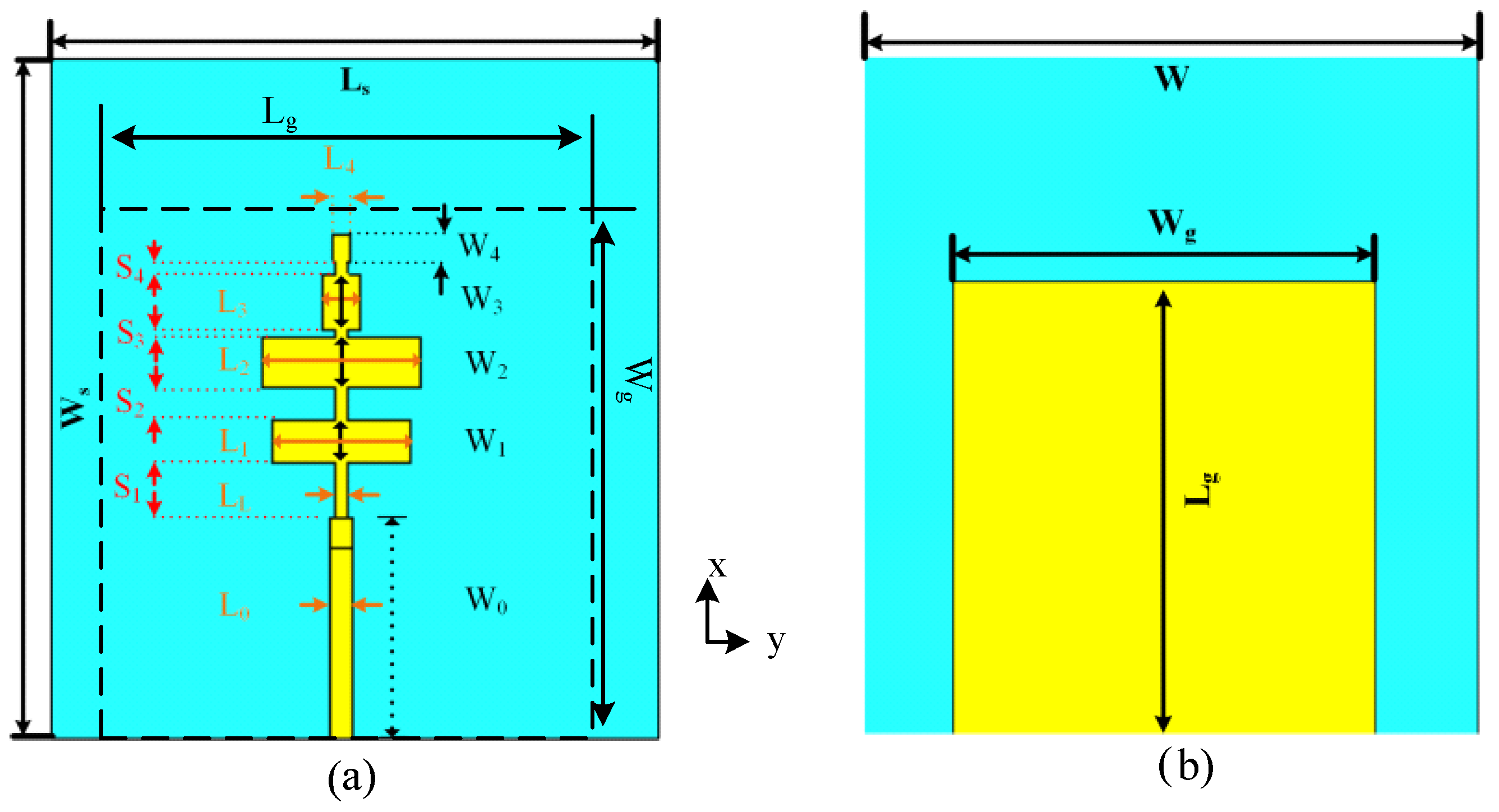
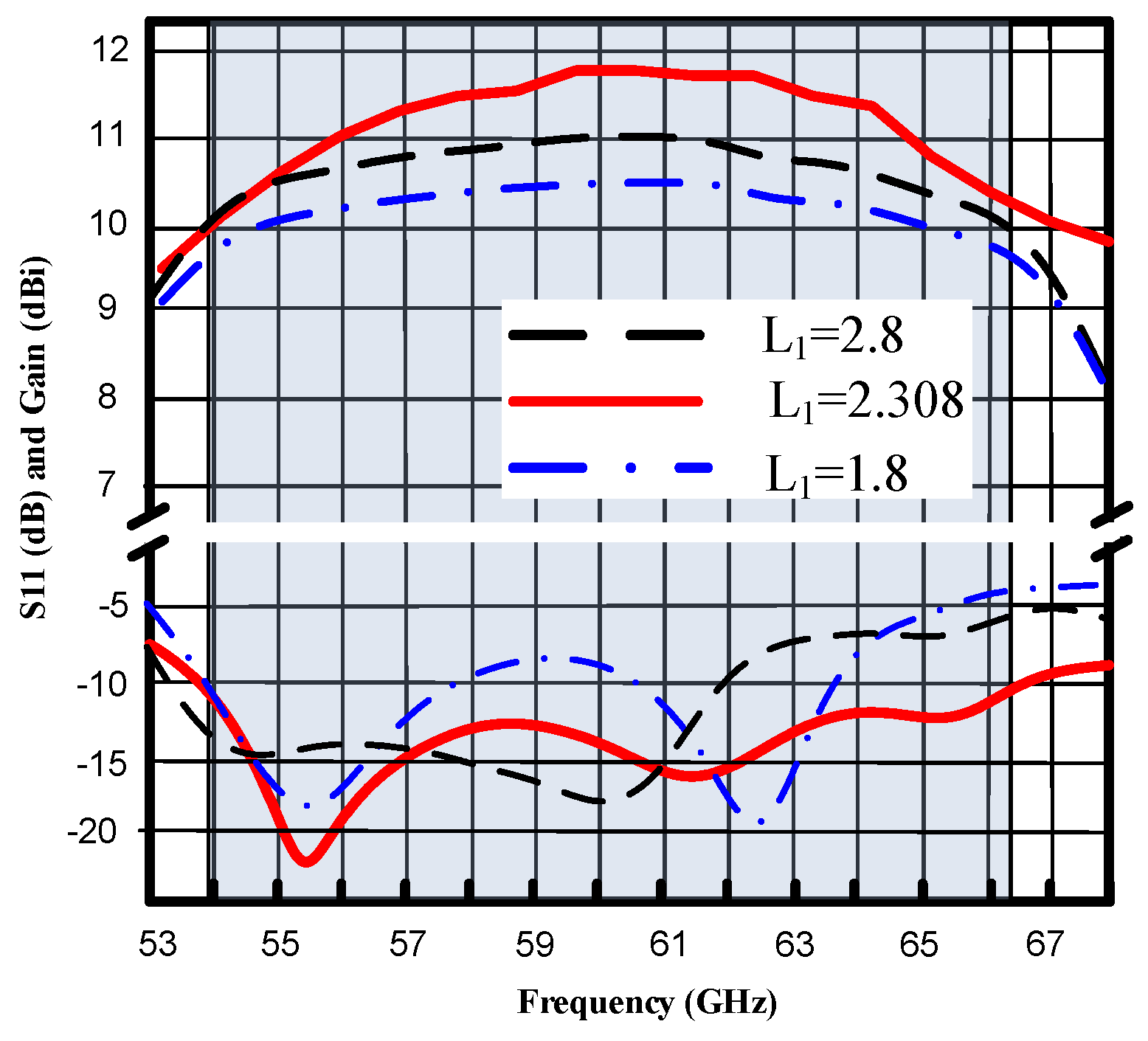
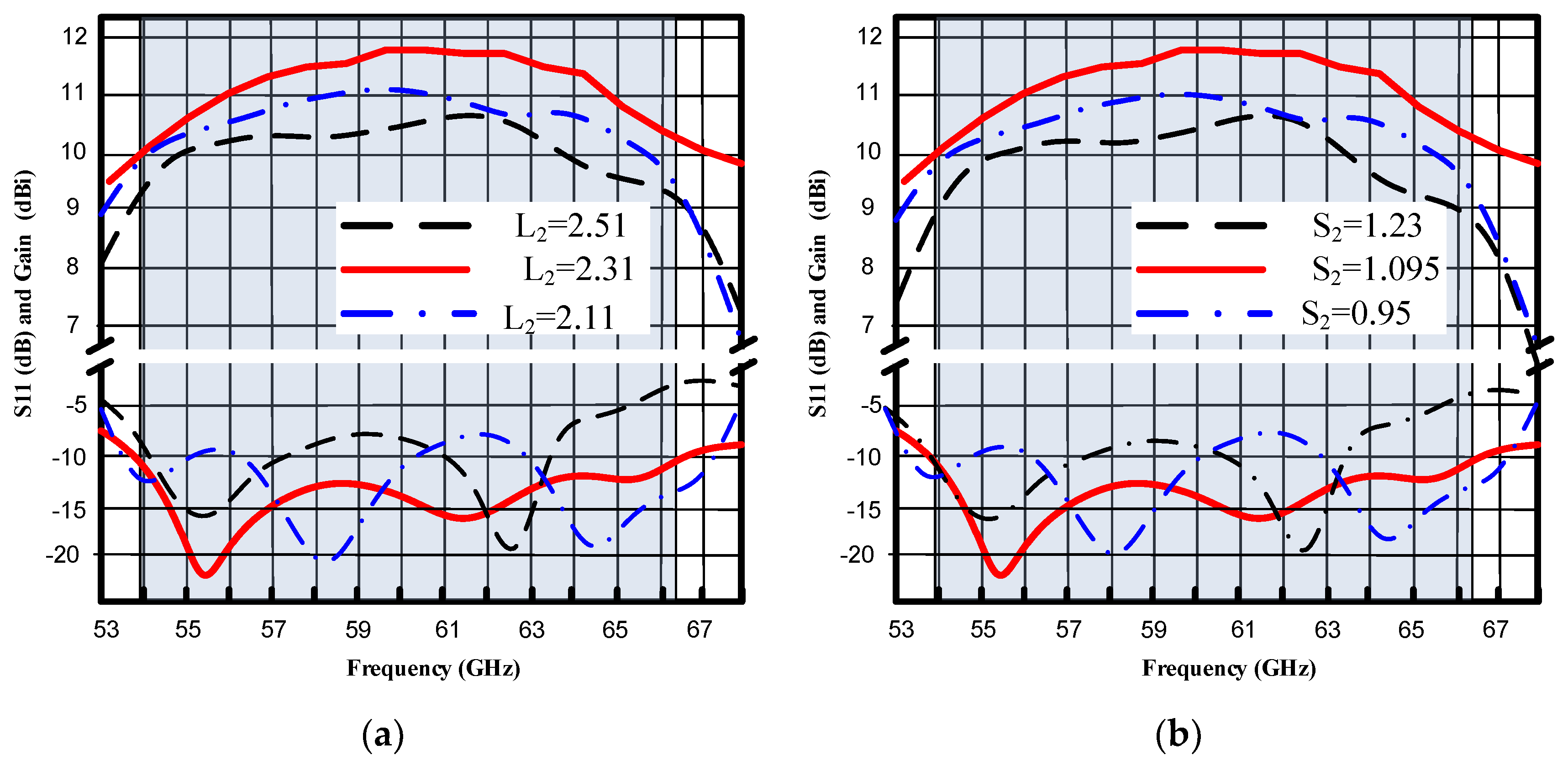
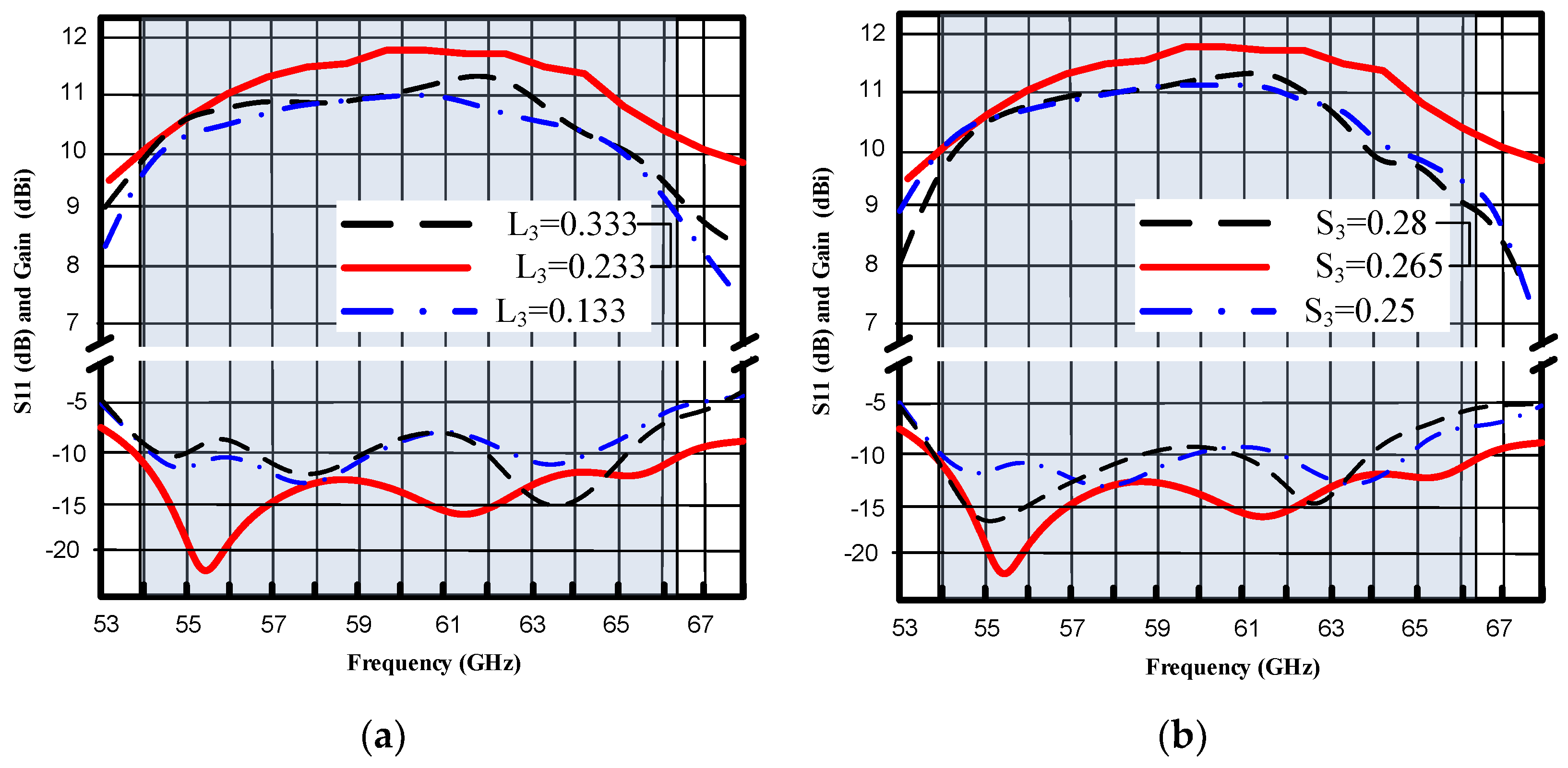
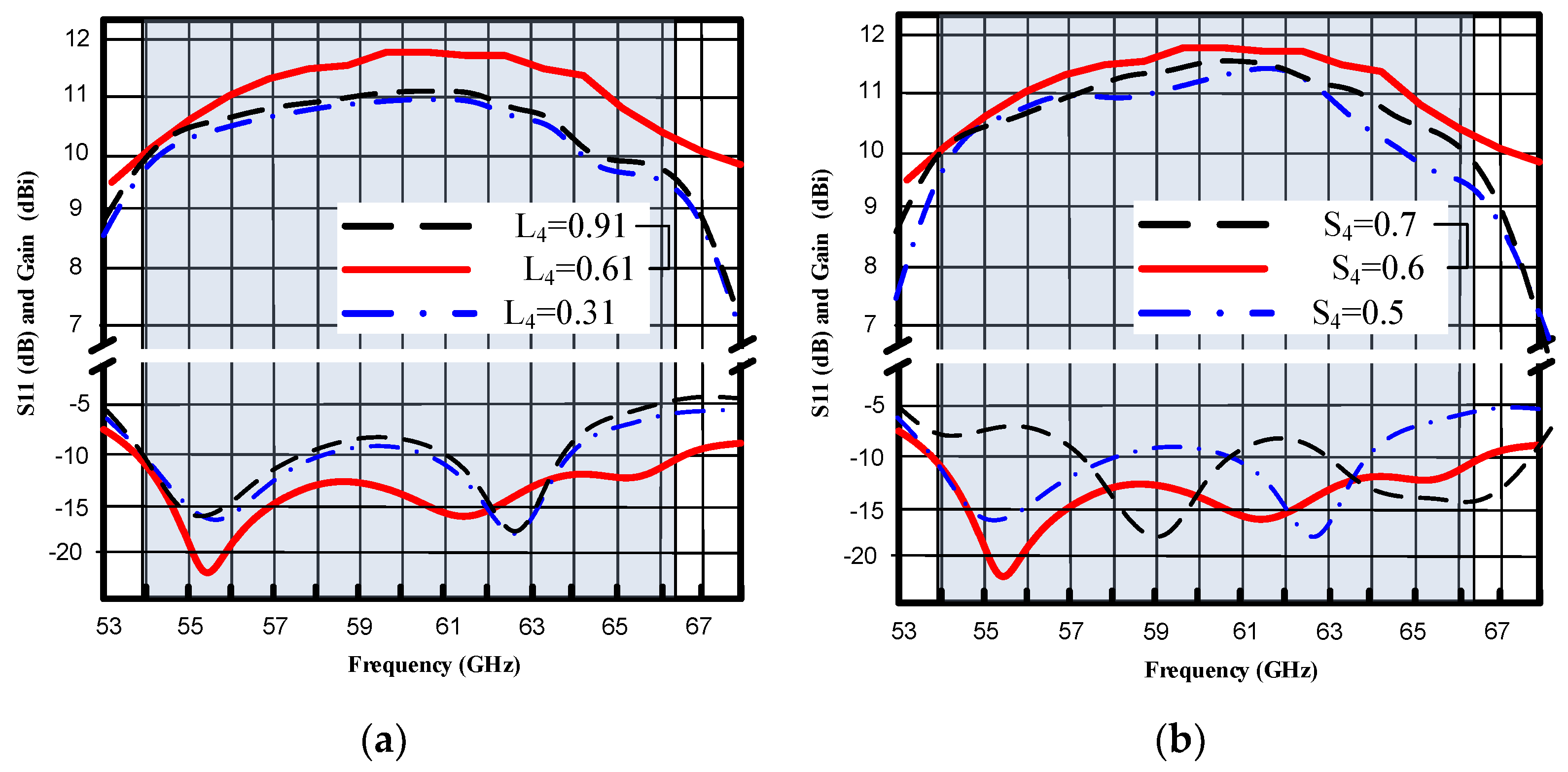
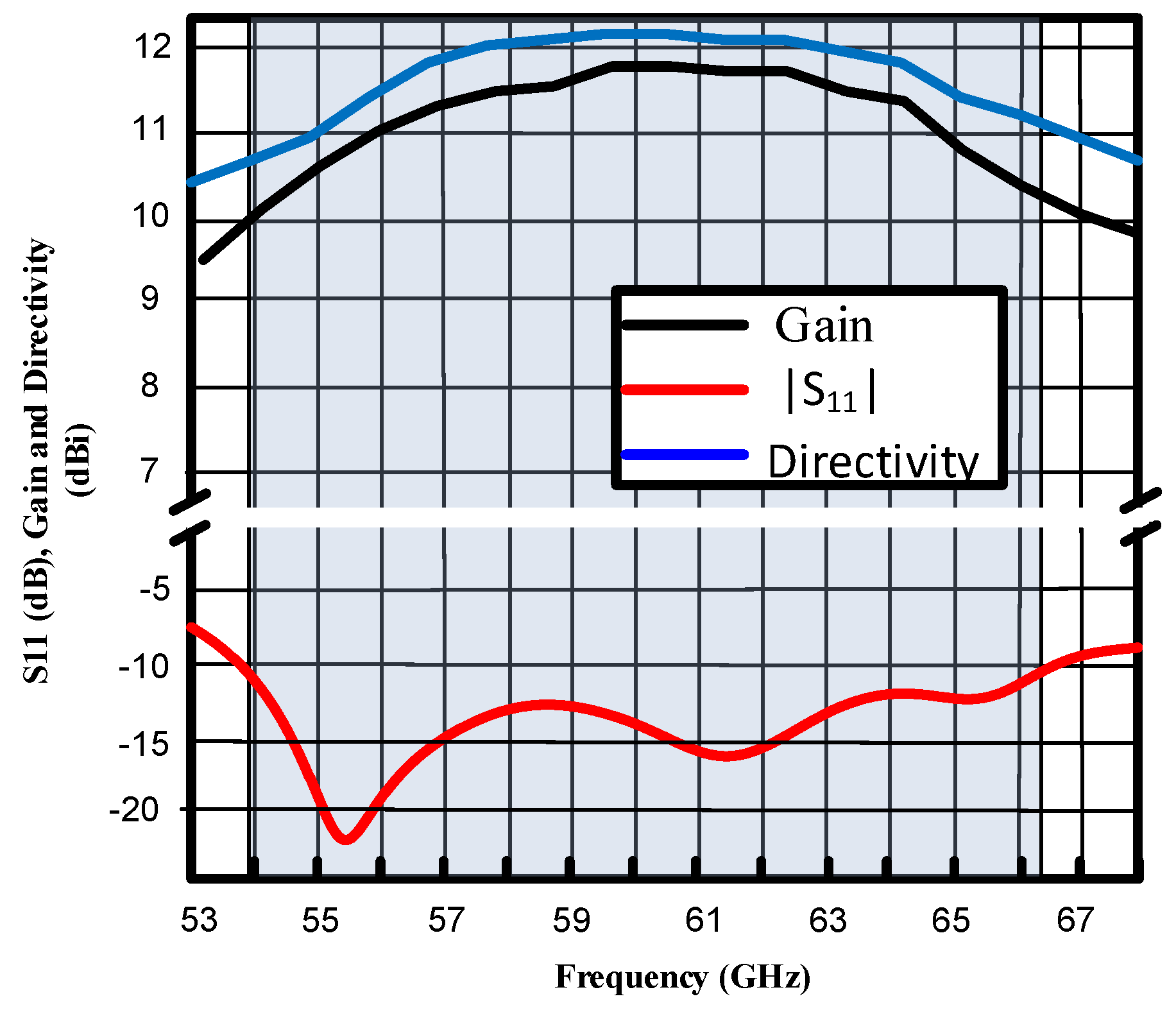
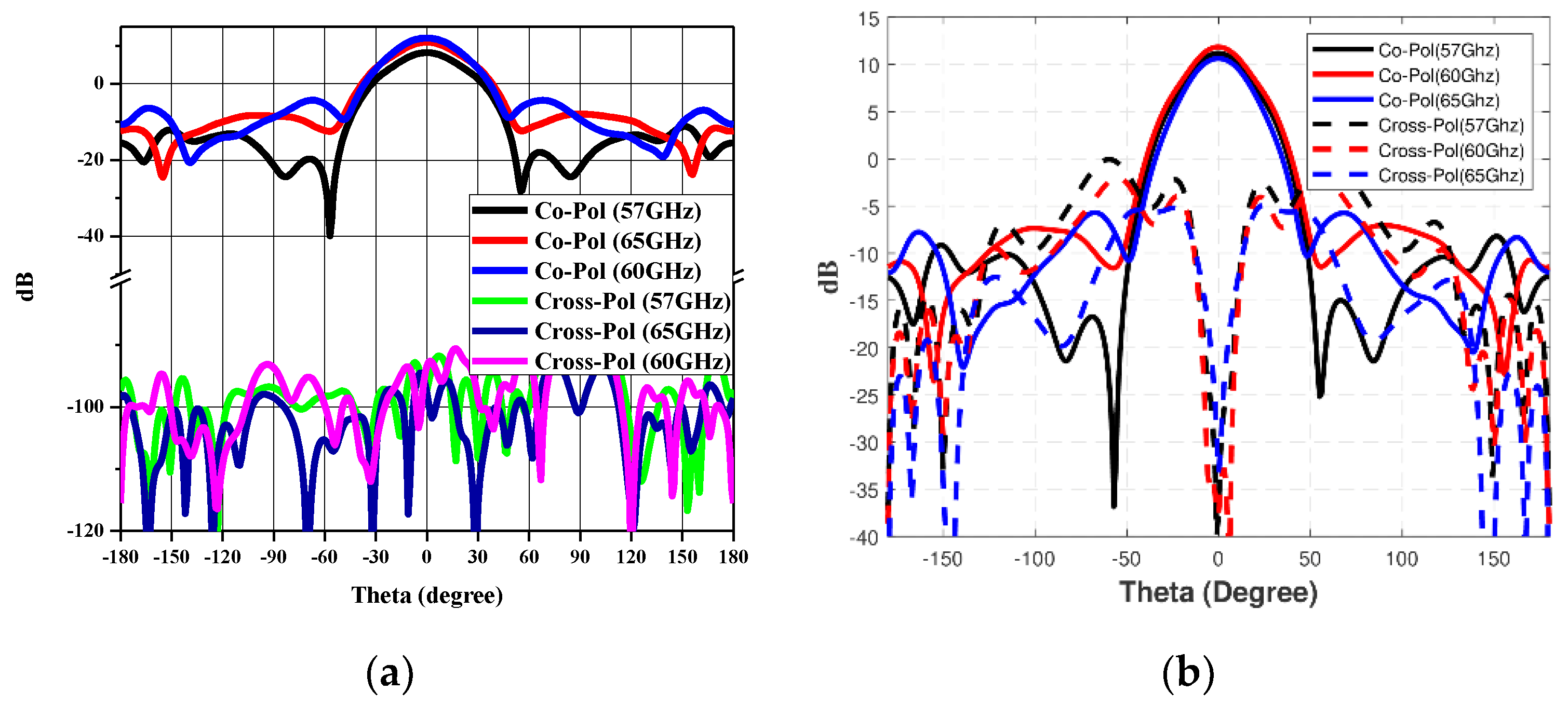
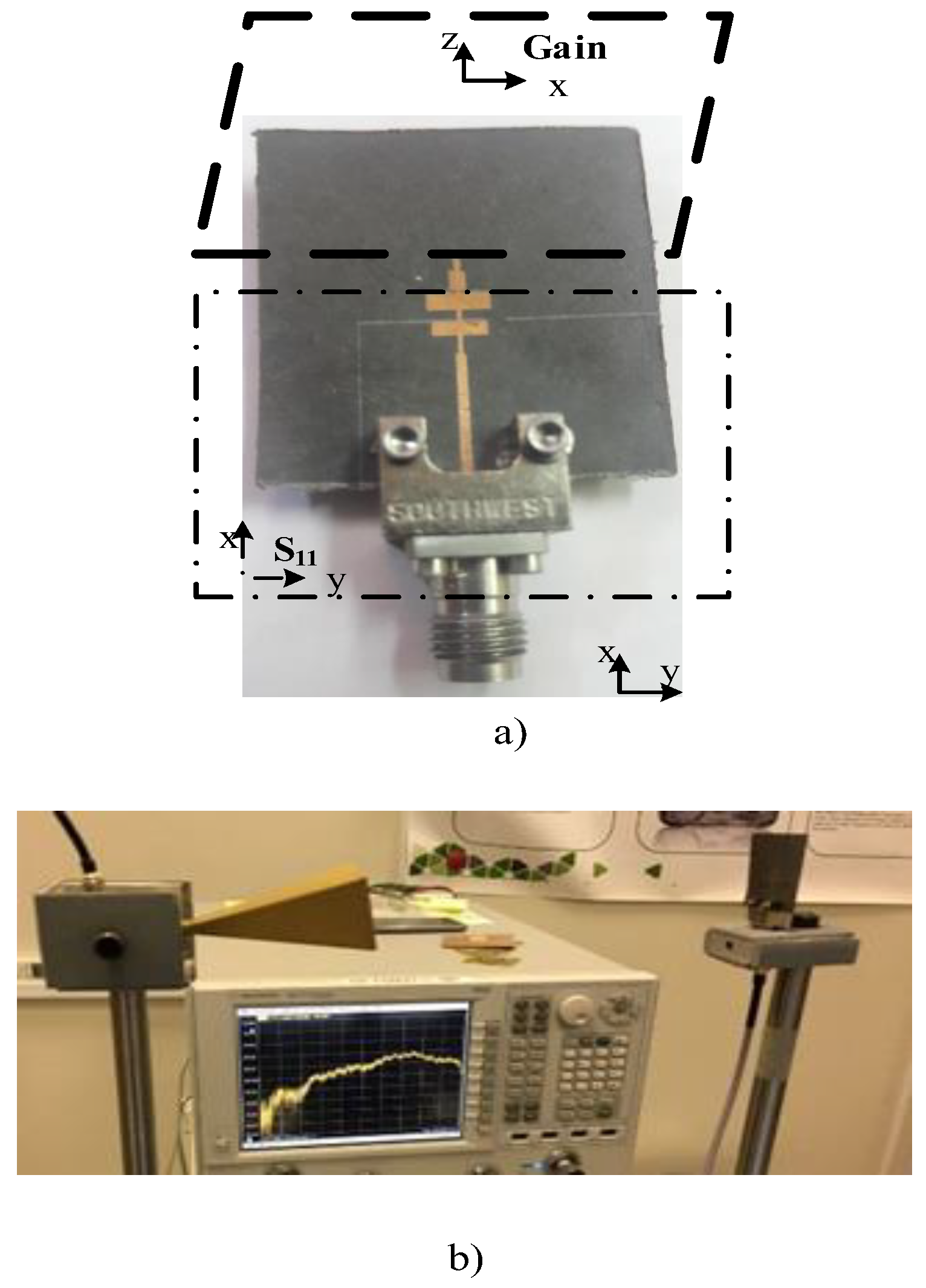
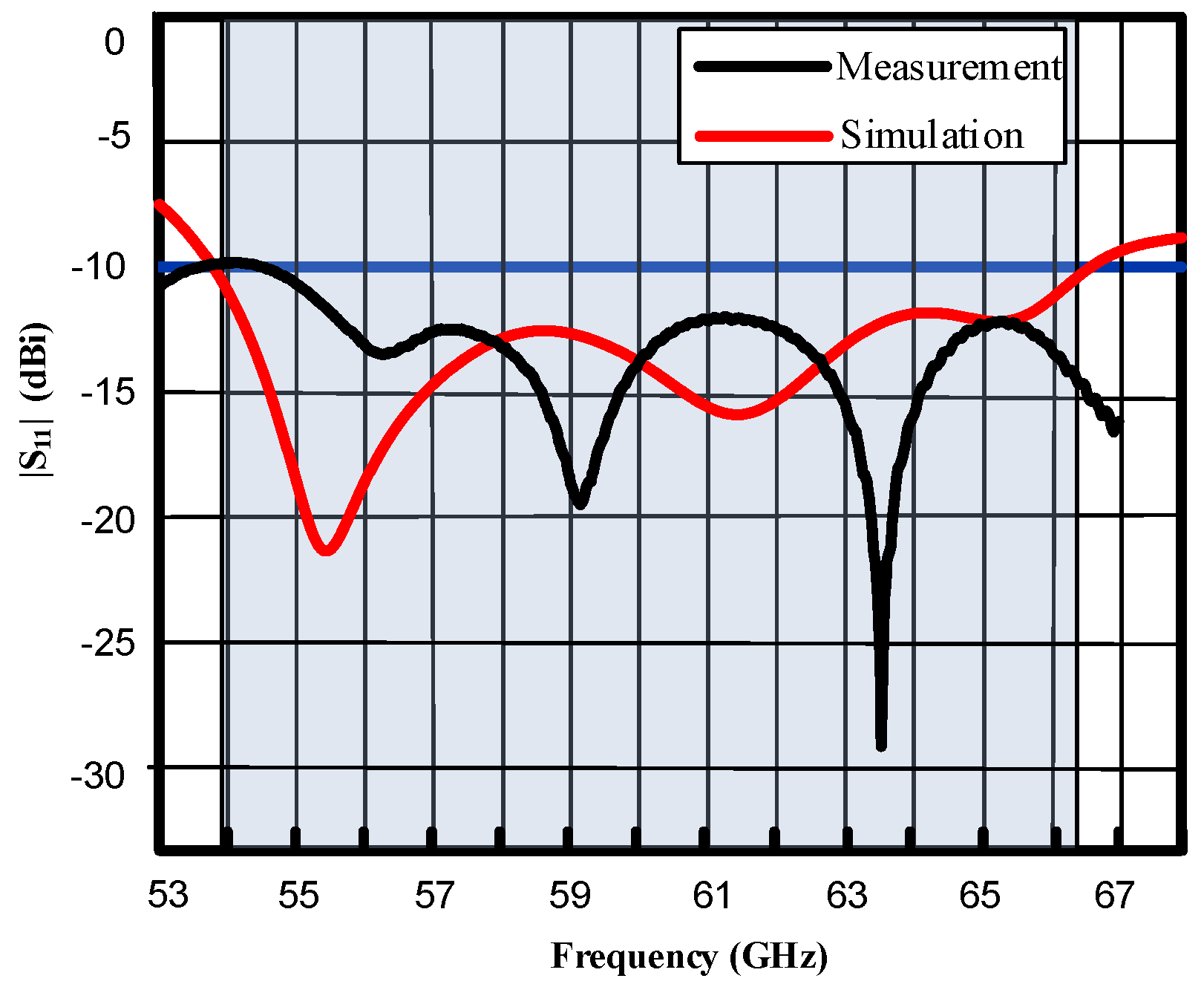
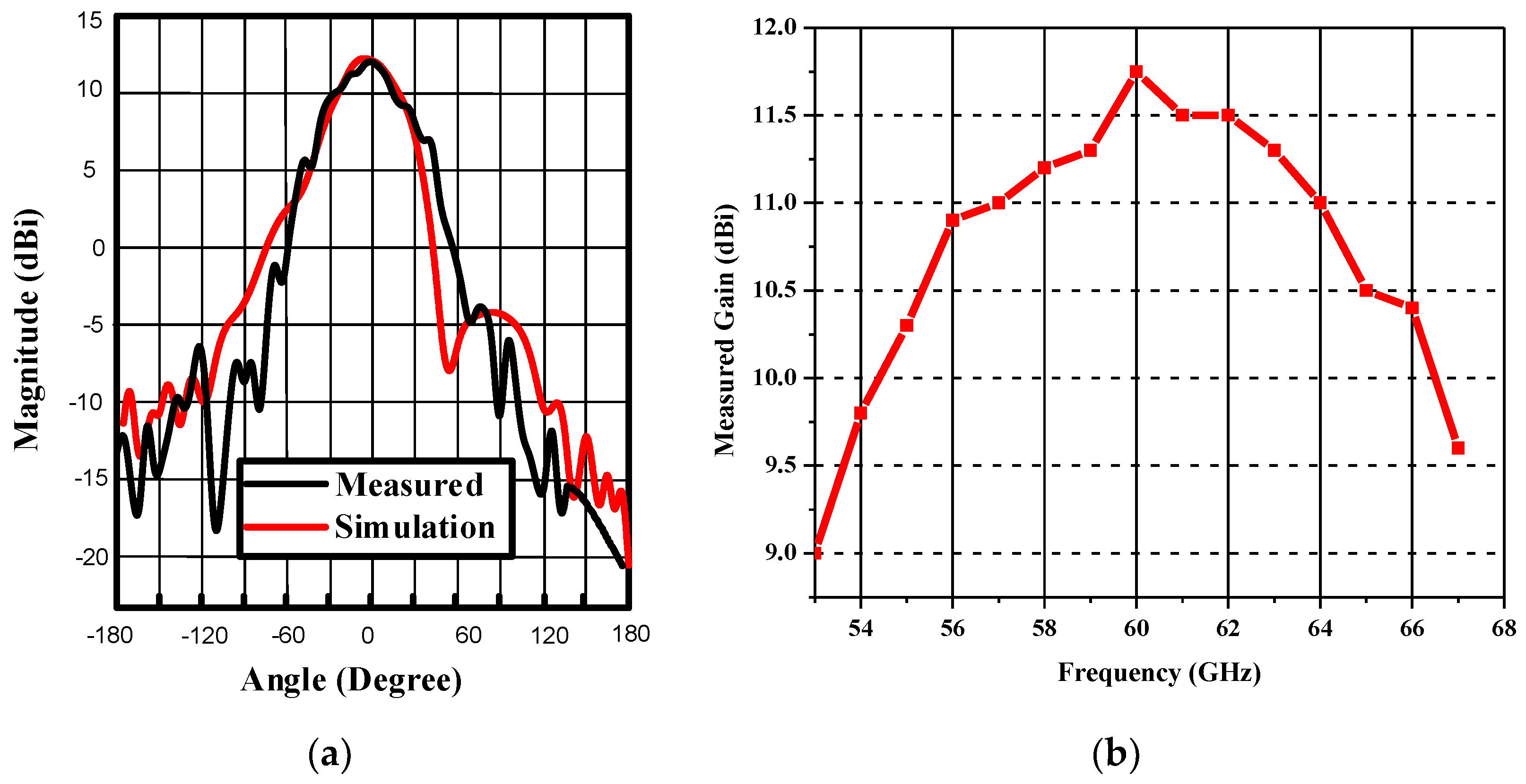
| LG | WG | LS | WS | L1 | W1 | S1 | W2 |
|---|---|---|---|---|---|---|---|
| 25 | 26.62 | 30 | 30 | 3.3 | 2.3 | 1.84 | 1.55 |
| L2 | S2 | L3 | W3 | S3 | L4 | W4 | S4 |
| 2.31 | 1.095 | 0.23 | 1.76 | 0.26 | 0.61 | 0.81 | 0.6 |
| Antenna Type | Bandwidth (GHz) | Gain at 60 GHz (dB) | Gain at 57–64 GHz (dB) |
|---|---|---|---|
| Superstrate Antenna [17] | 6.8% | 12 | 9.8–14.6 |
| Dual Band [24] | 4.35% | 9.3 | N.A |
| Circular contour feeding line [25] | 0.5% | 8.4 | −6.8 to 8.4 (58 to 62 GHz) |
| Linear feeding line [26] | N.A | 11.5 | 6.5 to 12 (58 to 62 GHz) |
| Annular Feeding Line [27] | 1.8% | 9.5 | −4 to 10.8 (58 to 62 GHz) |
| Yagi (PCB) [28] | 10.5% | 18 | n.a |
| Planar Antenna Array [29] | 4.2% | 22 | 20.4 to 17.6 (59–62) |
| Proposed work | 20.7% | 11.8 | >11.2 |
© 2019 by the authors. Licensee MDPI, Basel, Switzerland. This article is an open access article distributed under the terms and conditions of the Creative Commons Attribution (CC BY) license (http://creativecommons.org/licenses/by/4.0/).
Share and Cite
Issa, K.; Fathallah, H.; Ashraf, M.A.; Vettikalladi, H.; Alshebeili, S. Broadband High-Gain Antenna for Millimetre-Wave 60-GHz Band. Electronics 2019, 8, 1246. https://doi.org/10.3390/electronics8111246
Issa K, Fathallah H, Ashraf MA, Vettikalladi H, Alshebeili S. Broadband High-Gain Antenna for Millimetre-Wave 60-GHz Band. Electronics. 2019; 8(11):1246. https://doi.org/10.3390/electronics8111246
Chicago/Turabian StyleIssa, Khaled, Habib Fathallah, Muhammad A. Ashraf, Hamsakutty Vettikalladi, and Saleh Alshebeili. 2019. "Broadband High-Gain Antenna for Millimetre-Wave 60-GHz Band" Electronics 8, no. 11: 1246. https://doi.org/10.3390/electronics8111246
APA StyleIssa, K., Fathallah, H., Ashraf, M. A., Vettikalladi, H., & Alshebeili, S. (2019). Broadband High-Gain Antenna for Millimetre-Wave 60-GHz Band. Electronics, 8(11), 1246. https://doi.org/10.3390/electronics8111246




